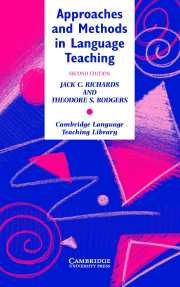Book contents
- Frontmatter
- Contents
- Preface
- Part I Major language trends in twentieth-century language teaching
- Part II Alternative approaches and methods
- 5 Total Physical Response
- 6 The Silent Way
- 7 Community Language Learning
- 8 Suggestopedia
- 9 Whole Language
- 10 Multiple Intelligences
- 11 Neurolinguistic Programming
- 12 The lexical approach
- 13 Competency-Based Language Teaching
- Part III Current communicative approaches
- Author index
- Subject index
7 - Community Language Learning
Published online by Cambridge University Press: 06 July 2010
- Frontmatter
- Contents
- Preface
- Part I Major language trends in twentieth-century language teaching
- Part II Alternative approaches and methods
- 5 Total Physical Response
- 6 The Silent Way
- 7 Community Language Learning
- 8 Suggestopedia
- 9 Whole Language
- 10 Multiple Intelligences
- 11 Neurolinguistic Programming
- 12 The lexical approach
- 13 Competency-Based Language Teaching
- Part III Current communicative approaches
- Author index
- Subject index
Summary
Background
Community Language Learning (CLL) is the name of a method developed by Charles A. Curran and his associates. Curran was a specialist in counseling and a professor of psychology at Loyola University, Chicago. His application of psychological counseling techniques to learning is known as Counseling-Learning. Community Language Learning represents the use of Counseling-Learning theory to teach languages. As the name indicates, CLL derives its primary insights, and indeed its organizing rationale, from Rogerian counseling (Rogers 1951). In lay terms, counseling is one person giving advice, assistance, and support to another who has a problem or is in some way in need. Community Language Learning draws on the counseling metaphor to redefine the roles of the teacher (the counselor) and learners (the clients) in the language classroom. The basic procedures of CLL can thus be seen as derived from the counselor–client relationship.
CLL techniques also belong to a larger set of foreign language teaching practices sometimes described as humanistic techniques (Moskowitz 1978). Moskowitz defines humanistic techniques as those that
blend what the student feels, thinks and knows with what he is learning in the target language. Rather than self-denial being the acceptable way of life, self-actualization and self-esteem are the ideals the exercises pursue. [The techniques] help build rapport, cohesiveness, and caring that far transcend what is already there … help students to be themselves, to accept themselves, and be proud of themselves … help foster a climate of caring and sharing in the foreign language class.
(Moskowitz 1978: 2)Information
- Type
- Chapter
- Information
- Approaches and Methods in Language Teaching , pp. 90 - 99Publisher: Cambridge University PressPrint publication year: 2001
